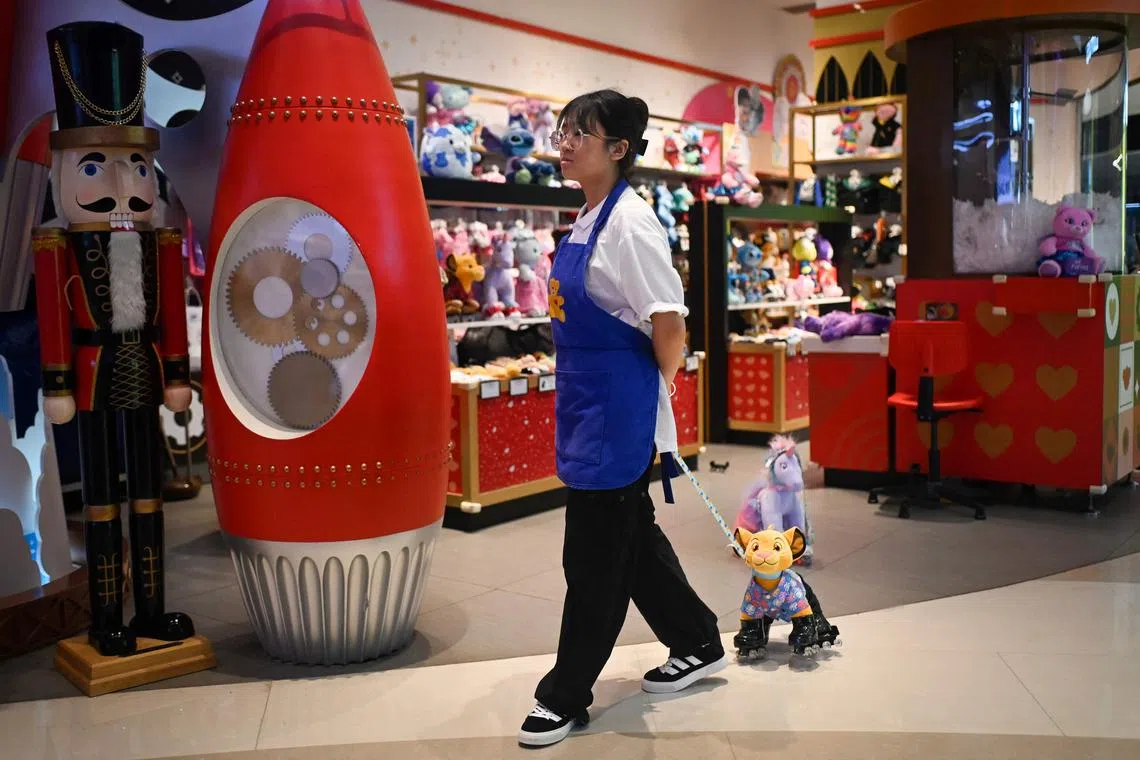News analysis
China’s deflationary spiral now entering dangerous new stage
Sign up now: Get ST's newsletters delivered to your inbox

A sales woman waits for customers at a toy store inside a mall at the Central Business District in Beijing.
PHOTO: AFP
Follow topic:
BEIJING - Deflation stalking China since 2023 is now showing signs of spiralling, threatening to worsen the outlook for the world’s second-largest economy and raising calls for immediate policy action.
Data released on Sept 9 confirmed that apart from food costs, consumer price growth barely registered in large swathes of the economy at a time when incomes are sagging.
A broader measure of economy-wide prices known as the gross domestic product (GDP) deflator will likely extend its current five-quarter drop into 2025, according to Bloomberg Economics and analysts at banks including BNP Paribas. That would amount to China’s longest streak of deflation since data began in 1993.
“We are definitely in deflation and probably going through the second stage of deflation,” said Mr Robin Xing, chief China economist at Morgan Stanley, citing evidence from wage decreases. “Experience from Japan suggests that the longer deflation drags on, the more stimulus China will eventually need to break the debt-deflation challenge.”
The danger for China is deflation could snowball by encouraging households reeling from falling pay cheques to cut back on spending, or delay purchases because they expect prices to fall further. Corporate revenues will suffer, stifling investment and leading to further salary cuts and layoffs, bankrupting families and firms.
Private surveys show that is already starting to happen. In sectors of the economy favoured by the government – such as electric vehicle manufacturing and renewables – entry level salaries declined by almost 10 per cent in August from a peak in 2022, according to findings by Caixin Insight Group and Business Big Data.
A survey of 300 company executives by the Cheung Kong Graduate School of Business showed growth in labour costs in August was the weakest since April 2020, when China’s initial Covid-19 lockdowns began to ease.
Separate data from Zhaopin shows average hiring salaries in 38 major cities barely changed in the second quarter, in contrast to the 5 per cent growth seen in the two years before the pandemic.
It is a cycle the world has seen before in Japan, starting in the 1990s during a period that came to be known as its “lost decades” – when a grinding stagnation followed a burst bubble in real estate and financial markets.
While Chinese officials have sought to stifle discussion about deflation, warning analysts to avoid using the term, it is beginning to enter public dialogue. Former central bank governor Yi Gang last week said rooting out deflation has to take priority for policymakers, a rare admission by a prominent figure in China that falling prices are threatening the outlook.
Mr Yi called for “proactive fiscal policy and accommodative monetary policy” and said officials “should focus on fighting deflationary pressure” at a panel discussion at the Bund Summit in Shanghai on Sept 13. China’s immediate goal should be to turn its GDP deflator positive in the coming quarters, he said.
So far, officials have given no sign of any significant shift from their cure-all of encouraging production rather than addressing weak demand with steps such as greater government spending on public services and consumer subsidies.
In a sign that price pressures are becoming even more subdued, China’s core inflation – which strips out volatile items such as food and energy – cooled in August to the weakest in more than three years. Expectations for deflation are spilling into markets, stoking a bond rally that has sent yields to record lows and stoked official concerns that banks have become too exposed to interest rate risks.
The weak price pressures are evident in the growth pace of China’s nominal GDP, which expanded just 4 per cent in the second quarter – well under the nation’s real economic growth goal of around 5 per cent in 2024.
At times of weak price gains, nominal expansion is a more useful indicator because it better reflects changes in wages, profits and government revenue, Yuekai Securities chief economist Lui Zhiheng wrote in a note in September.
For Mr Jack Liu, a 37-year-old sales engineer of aluminium products in southern China, the impact hit home after realising he no longer ordered extra eggs at breakfasts.
Plummeting market demand forced his company to cut prices and sell at a loss in 2023. That slashed his income to less than a 10th of what once exceeded one million yuan (S$184,000), making mortgage payments a struggle.
“The country doesn’t admit there’s deflation,” said Mr Liu, who lives in Foshan in Guangdong province. He has a modest following of 1,100 people on the Instagram-like Xiaohongshu, where he warns regularly about the danger of deflation.
The speed of deterioration in China’s price outlook has taken the market by surprise.
Inflation was weaker than forecast in three of the past four months, growing just 0.6 per cent in August – an increase due largely to a 2.8 per cent pickup in food prices. Core inflation in August rose just 0.3 per cent to remain below 1 per cent for the 18th month.
Underscoring the drag on inflation, producer prices have been falling since late 2022. Manufacturers’ raw material and selling prices both contracted for the second month in August, official data shows, while charges by services and construction companies shrank at the fastest pace since April 2020.
Meanwhile, the deflationary mindset is starting to take hold. Consumer confidence is hovering at a record low and households report a growing willingness to save instead of spending or buying homes.
For Mr Liu, the aluminium industry worker, the solution lies with policymakers in Beijing. “The government needs to at least take some concrete measures to lift consumption and improve people’s expectations,” he said. BLOOMBERG

